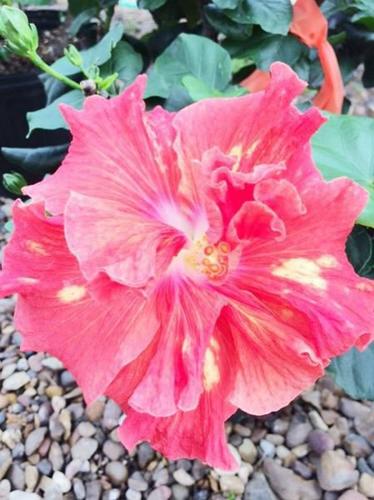Sun showers, fifth dimension, rum runner or gold rain. No, they are not a forecast description for this weekend's weather; they are the names of the beautiful and poignant varieties of the exotic hybrid hibiscus.
Exotic blooms
You might ask, "In South Texas?"
Absolutely. All you have to do is walk outside your own back door. Exotic hibiscus are a tropical hybrid hibiscus that stay green year-round and produce breathtaking, trumpet-shaped flowers.
Descendents of small hibiscus
These particular hibiscus blooms are descendants of the small hibiscus flower that we all are very familiar with in this area. There are various flowers with numerous stamens, which produce these vibrant, eye-catching blooms. Their flowers are short-lived but are quickly replaced by yet another eager bloom.
Dwarf in size
Exotic hibiscus bushes do not typically grow as large as a garden variety hibiscus, but nothing is more rewarding than the beautiful, multicolored and multishaped blooms. Because of their smaller size, they can be grown in either containers or in landscaped beds.
Growing conditions
Landscaping with exotic hibiscus on the Gulf Coast can create a tropical feel right in your own backyard. Loose, well-drained soil is definitely preferred. They also require full sun as sunlight is needed to produce blooms. Inadequate and insufficient sunlight will leave you with a green bush and no blooms.
Watering
A steady supply of water should be given because of South Texas heat. Be careful not to over water; it can prove to be too stressful to the plant and can be as damaging as the lack of water. In colder weather, it is not necessary to water as much.
Freeze damage
The exotic hibiscus does not tolerate freezing temperatures. Well-watered and properly fertilized plants will fare better. Protective and adequate coverings will also aid in protection for the plant.
Pruning
You may prune your hibiscus in early spring after the last chance of frost. You may cut back to the desired length and do so with clean, sharp pruning shears. For the rest of the growing season, you may lightly prune to maintain the shape of the shrub.
Wind damage
Strong winds on the Gulf Coast may damage the leaves, but they will recover rather quickly.
Fertilization
Hibiscus plants have a voracious appetite for potassium. It draws water into every plant cell, keeping each cell full, hydrated and healthy, which in turn, makes the plant more lush and attractive as well as more resistant to drought and disease. Use fertilizer, especially for hibiscus for best results.
Threat from insects
The hibiscus is susceptible to insects, but they can be controlled with proper products and applications.
Mealy bugs
Mealy bugs are small insects that secrete a sugary substance that attracts ants. Mealy bugs can be controlled with a light oil spray or insecticidal soap applied to the leaves. Make sure to spray on the underside of hibiscus leaves to dislodge and better control the removal of the insects.
Aphids
Aphids are soft-bodied, sucking insects that excrete a honeydew substance. They produce quickly and suck the sap from the stems and leaves of the plant. Insecticidal soap works extremely well in controlling these as well.
Thrips
Thrips are very tiny insects which have piercing mouth parts that can do much damage to the plant. The thrips often gird the stem where it connects to the base, often resulting in the buds dropping from the plant. An insecticidal soap may be used for their hasty removal to prevent damage to the stem and loss of bloom.
Attraction to pollinators
The variations of exotic hibiscus are astounding. A multitude of colors are available; it's just a matter of color preference. These tropical beauties are sought after for their vibrant and eye-catching colors - and not just by us. Their long stamens also draw the eye of valuable pollinators, such as hummingbirds and butterflies, which are an added bonus to any landscape.
Exotic hibiscus plants are excellent performers, and with just a small amount of care, they reward us with their glorious, showstopping blooms.
Next time you are in the mood to experience an exotic tropical location, you may only have to travel as far as your own backdoor.
The Gardeners' Dirt is written by members of the Victoria County Master Gardener Association, an educational outreach of Texas AgriLife Extension - Victoria County. Mail your questions in care of the Advocate, P.O. Box 1518, Victoria, TX 77901 or vcmga@vicad.com, or comment on this column at VictoriaAdvocate.com.








